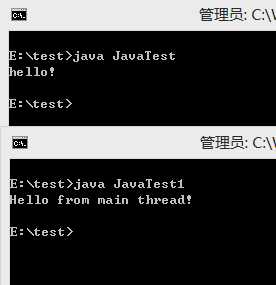标签:stream explicit 之间 交换 his generate 影响 exit code
System类构造函数由private修饰,不可以被实例化,加载时调用static代码块。
System类提供了标准输入输出流,错误输出流;其中out和err的类型是PrintStream
/** * The <code>System</code> class contains several useful class fields * and methods. It cannot be instantiated. * * <p>Among the facilities provided by the <code>System</code> class * are standard input, standard output, and error output streams; * access to externally defined properties and environment * variables; a means of loading files and libraries; and a utility * method for quickly copying a portion of an array. * * @author unascribed * @since JDK1.0 */ public final class System { /* register the natives via the static initializer. * * VM will invoke the initializeSystemClass method to complete * the initialization for this class separated from clinit. * Note that to use properties set by the VM, see the constraints * described in the initializeSystemClass method. */ private static native void registerNatives(); static { registerNatives(); } /** Don‘t let anyone instantiate this class */ private System() { }
System.exit(int),终止当前虚拟机的运行,什么叫做当前虚拟机呢?
public static void exit(int status) { Runtime.getRuntime().exit(status); }
如果在某个线程中调用了exit会怎样?下面的例子输出结果是hello,把子线程和主线程的内容交换也是一样的结果。就是说不管在哪个线程调用了exit,整个应用都退出了。
package com.ysdx.test; public class JavaTest { public static void main(String[] args) { Thread thread = new Thread(() -> { try { Thread.sleep(1000); } catch (InterruptedException e) { // TODO Auto-generated catch block e.printStackTrace(); } System.out.println("hello!"); System.exit(1); }); thread.start(); try { Thread.sleep(3000); } catch (InterruptedException e) { // TODO Auto-generated catch block e.printStackTrace(); } System.out.println("Hello from main thread!"); } }
两个虚拟机之间是互不影响的

其中JavaTest1如下
public class JavaTest1 { public static void main(String[] args) { try { Thread.sleep(3000); } catch (InterruptedException e) { // TODO Auto-generated catch block e.printStackTrace(); } System.out.println("Hello from main thread!"); } }
---------------------
System中gc相关操作
/** * Runs the garbage collector. * <p> * Calling the <code>gc</code> method suggests that the Java Virtual * Machine expend effort toward recycling unused objects in order to * make the memory they currently occupy available for quick reuse. * When control returns from the method call, the Java Virtual * Machine has made a best effort to reclaim space from all discarded * objects. * <p> * The call <code>System.gc()</code> is effectively equivalent to the * call: * <blockquote><pre> * Runtime.getRuntime().gc() * </pre></blockquote> * * @see java.lang.Runtime#gc() */ public static void gc() { Runtime.getRuntime().gc(); } /** * Runs the finalization methods of any objects pending finalization. * <p> * Calling this method suggests that the Java Virtual Machine expend * effort toward running the <code>finalize</code> methods of objects * that have been found to be discarded but whose <code>finalize</code> * methods have not yet been run. When control returns from the * method call, the Java Virtual Machine has made a best effort to * complete all outstanding finalizations. * <p> * The call <code>System.runFinalization()</code> is effectively * equivalent to the call: * <blockquote><pre> * Runtime.getRuntime().runFinalization() * </pre></blockquote> * * @see java.lang.Runtime#runFinalization() */ public static void runFinalization() { Runtime.getRuntime().runFinalization(); }
顺便看一下Runtime,
即便不显示调用gc,JVM也会自动在一个单独的线程中执行recycling process;
即便不显示调用runFinalization,JVM也会自动在一个单独的线程中执行finalization process;
可以很明显的看出gc和runFinalization是不同的,一个叫做回收过程,一个叫做终结过程。
调用runFinalization后,终结过程会调用已经被废弃但是尚未调用其finalization方法的对象。
函数注释里的描述都使用了suggest和has made its best effort,可能这两个函数还有不足之处。
/** * Runs the garbage collector. * Calling this method suggests that the Java virtual machine expend * effort toward recycling unused objects in order to make the memory * they currently occupy available for quick reuse. When control * returns from the method call, the virtual machine has made * its best effort to recycle all discarded objects. * <p> * The name <code>gc</code> stands for "garbage * collector". The virtual machine performs this recycling * process automatically as needed, in a separate thread, even if the * <code>gc</code> method is not invoked explicitly. * <p> * The method {@link System#gc()} is the conventional and convenient * means of invoking this method. */ public native void gc(); /* Wormhole for calling java.lang.ref.Finalizer.runFinalization */ private static native void runFinalization0(); /** * Runs the finalization methods of any objects pending finalization. * Calling this method suggests that the Java virtual machine expend * effort toward running the <code>finalize</code> methods of objects * that have been found to be discarded but whose <code>finalize</code> * methods have not yet been run. When control returns from the * method call, the virtual machine has made a best effort to * complete all outstanding finalizations. * <p> * The virtual machine performs the finalization process * automatically as needed, in a separate thread, if the * <code>runFinalization</code> method is not invoked explicitly. * <p> * The method {@link System#runFinalization()} is the conventional * and convenient means of invoking this method. * * @see java.lang.Object#finalize() */ public void runFinalization() { runFinalization0(); }
标签:stream explicit 之间 交换 his generate 影响 exit code
原文地址:http://www.cnblogs.com/afraidToForget/p/6625357.html